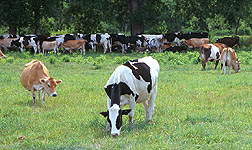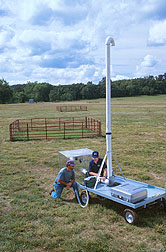Grass-Based Farming: A Demo Dairy Project
The Cove Mountain Project has a neat, top-secret military ring to it. In reality, it's the name for a demonstration dairy farm owned by the American Farmland Trust (AFT) in Franklin County, south-central Pennsylvania.
Each month, Cove Mountain is besieged by a small army of agricultural researchers tending to various experiments on the 300-plus-acre farm. Data generated there by meteorological and other instrumentation are helping the scientists gauge the economic and environmental merits of an alternative approach to dairying.
In short, it calls for grazing dairy cows on intensively managed grass and legume pastures instead of confining the animals indoors and feeding them hay, grain, or cut forage.
Dairy farmer Glenn Moyer first began operating the farm in March 1998 as both an AFT demo project and a commercial dairy.
"It should be recognized there's more than one way to dairy," says Bryan Petrucci, AFT's Cove Mountain Farm project director. "Our aim is to use the farm as a place where people can learn about the economic and environmental benefits of grass-based farming."
According to several estimates, grazing-based systems on small to medium-sized dairies can boost net income by $50 to $100 per cow. Computer simulations on ARS' Dairy Forage System Model generally bear this out, say agricultural engineer C. Alan Rotz and animal scientist Kathy J. Soder, who are at the ARS Pasture Systems and Watershed Management Research Laboratory (PSWMRL) in University Park, Pennsylvania.
Preliminary analyses with the model have shown that this low-input approach at Cove Mountain may increase net income up to twice this amount.
Cows in full-confinement operations generally produce higher milk yields than those that graze. The benefit of grazing comes from lower production costs and less labor.
For those who try it, the secret to success isn't hiking milk production, but rather decreasing operating costs associated with growing, harvesting, and storing crops like corn as year-round feed—a standard practice for full-confinement operations. There's also less capital investment than is associated with managing and housing large dairy herds, says Petrucci.
|
|
Still, some northeastern dairy farmers remain skeptical, he acknowledges. "To Glenn's credit, he's a leader and not afraid to try new things," says Petrucci.
For researchers, the Cove Mountain farm is a unique opportunity to collect scientifically defensible data on the economics and sustainability of grazing-based systems from a commercial operation. Thanks in great part to Moyer and AFT, visiting scientists can carry out their experiments to that end in a controlled manner.
Monitoring Animal Wastes
A chief interest of the scientists is determining the extent to which waste from grazing animals contributes to nitrate leaching or phosphorus runoff. Both can diminish water quality. Consider that on average, an adult cow excretes 2 to 3 quarts of urine a dozen times daily and defecates 4 pounds of manure about as often—and that's 7 days a week, 52 weeks a year.
"Only about 15 percent of the nutrients contained in pasture herbage leave the pasture as milk or meat. The remaining 85 percent are recycled onto the pasture in urine or manure," says PSWRML soil scientist William L. Stout.
And because "85 percent of the nutrients are recycled onto only about 15 percent of the pasture," he adds, "the concentrations beneath urine or manure patches are very high."
The challenge, then, is improving management of these pasture wastes.
Under certain conditions, wasteborne nutrients can outpace what pasture plants, soil microbes, and other biological processes can recycle or convert into forms less damaging to water quality. For example, excess phosphorus in runoff can harm recipient streams, lakes, or reservoirs by triggering algal blooms.
To address these concerns, Stout and colleague ARS soil scientist Stephan R. Weaver closely monitor various instruments set up at the farm. One site is a 10-acre paddock where they can monitor nutrients from the cow's urine and manure. Unbeknownst to the placid animals, the paddock is home to roughly 10,000 feet of underground piping.
This network, or drainage tile, captures water flowing beneath the paddock and directs it to five, keg-size sampling devices. Each is located in a flume house a few hundred yards from Little Cove Creek and about a mile or so from the hulking green shoulders of Cove and Cross Mountains.
Ecological Benefits and Drawbacks
Walking from the flume house during a June visit to the farm, Stout notes some pros and cons to grazing.
Without a corn crop to worry about—unless grown for winter feed—a grazier doesn't have to spray chemical pesticides. This cuts the risk of drift beyond the field and spares beneficial insects, like bees. What's more, it minimizes erosion because the pasture's plants keep soil firmly anchored.
And by keeping herds out on pasture, rather than indoors, less fuel and labor are spent spreading manure and harvesting feed. This minimizes offensive odors and further cuts the grazier's expenses.
"But on the other hand," says Stout, "there's the potential for greater nitrate loss to groundwater because of the concentrated deposition of urine and manure."
Another concern is the impact of selective grazing and constant trampling by cows on the habitat, diversity, and productivity of grasses like orchardgrass, bluegrass, or tall fescue and legumes like clover and alfalfa.
Understanding these ecological changes, including their effect on pasture productivity, is the focus of ARS scientists R. Howard Skinner, Matt A. Sanderson, and Benjamin J. Tracy, all from University Park, about 2 hours north of Cove Mountain.
About once a week, they visit the farm to examine the height, density, and distribution of pasture plants. They also take root samples, along with photosynthetic and carbon partitioning measurements.
Skinner uses a 3-foot-wide Plexiglas chamber to collect photosynthetic data. During visits, he'll place the chamber over grassy patches inside and outside each of the farm's six fenced exclosures.
According to farm records dating back to 1968, no livestock have grazed inside the exclosures, a stroke of luck for scientists. Such virgin territory allows them to compare the plants' health and productivity with those in other pasture areas regularly grazed by the farm's 106 Jersey and Holstein cows.
Flipping a switch on the chamber's control panel, Skinner starts a motor that draws in air and pipes it into the chamber. Of chief interest is the rate at which pasture plants absorb carbon dioxide to drive photosynthesis. The rate at which carbon is stored gives scientists a clue to the productivity of pasture plants.
"We want to see if there's a difference in pasture production levels when it's cut for hay versus when it's grazed," says Skinner. In dairy circles, "there's been some question as to whether it's better to graze, or to cut a pasture for hay."
For Cambridge, New Zealand, graziers Ron Geck and his wife Willy, who visited Glenn Moyer in June, there's no better alternative, because of high feed costs and other prohibitive expenses.
Sitting at a picnic table in front of the farm's main home, Ron likens the practice to playing chess. "When you're grazing, set your farm up so you can still graze under difficult conditions," he says. Drawing on 30 year's experience, he adds "grazing's a science and should be treated that way."—By Jan Suszkiw, Agricultural Research Service Information Staff.
This research is part of Animal Production Systems (#102); Rangelands, Pastures, and Forages (#205); and Water Quality and Management (#201), ARS National Programs described on the World Wide Web at http://www.nps.ars.usda.gov/programs/appvs.htm
http://www.nps.ars.usda.gov/programs/nrsas.htm.
Scientists mentioned in this article are at the USDA-ARS Pasture Systems and Watershed Management Research Laboratory, Bldg. 3702, Curtin Rd., University Park, PA 16802; phone (814) 863-0947, fax (814) 863-0935, e-mail ws1@psu.edu.
American Farm Trust hosts a Cove Mountain Farm web site at http://grassfarmer.com.
"Grass-Based Farming: A Demo Dairy Project" was published in the October 1999 issue of Agricultural Research magazine.









